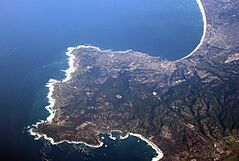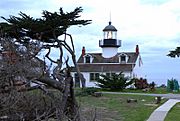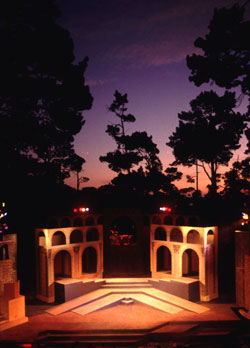Monterey Peninsula facts for kids

Aerial view of the Monterey Peninsula as seen from a jet airliner
|
|
| Geography | |
|---|---|
| Location | California |
| Coordinates | 36°35′45″N 121°55′50″W / 36.59583°N 121.93056°W |
| Adjacent bodies of water | Pacific Ocean |
| Administration | |
The Monterey Peninsula is a beautiful area on the Central Coast of California. It includes the cities of Monterey, Carmel, and Pacific Grove. It also features the famous resort area of Pebble Beach.
Contents
History of the Peninsula
Monterey's Beginnings

The city of Monterey was started in 1770. It was founded by a missionary named Junípero Serra and an explorer named Gaspar de Portolà. Portolà built a fort, called the Presidio of Monterey, to protect the port. This was to stop any possible invasion by Russian traders.
At the same time, Serra started Mission San Carlos Borromeo. This was the second mission in the chain of Spanish Missions of California. It was first near the fort but later moved a few miles south to its current spot.
Monterey was the capital of upper California from 1777 to 1848. It was ruled by Spain, then Mexico, and finally the United States. The city was once the only place where ships could bring goods into California and pay taxes. All goods coming by sea had to pass through the Custom House. This is the oldest government building in California.
The Custom House was built in three stages. Construction started in 1814 under Spanish rule. The middle part was built by Mexico in 1827. The last part was finished by the United States in 1846. Monterey was also where the Battle of Monterey happened on July 7, 1846, during the Mexican–American War. On that day, John D. Sloat from the United States Navy raised the U.S. flag over the Custom House. He claimed California for the United States.
Many "firsts" for California happened in Monterey. These include the First theater in California, the first brick house, and the first publicly funded school. It also had the first public building, public library, and printing press. This press printed The Californian, which was the first newspaper.
Colton Hall was built in 1849 by Walter Colton. It was first a public school and a meeting place for the government. California's first meeting to write its constitution was held there. Today, it is a museum. The buildings next to it are used for local government. The Monterey post office opened in 1849. Monterey officially became a city in 1889.
The city was also a famous place for California painters in the late 1800s and early 1900s. Artists like Arthur Frank Mathews and Armin Hansen lived or visited here. They painted outdoors, a style called En plein air. Many famous writers also lived in the Monterey area. These include John Steinbeck, Robinson Jeffers, and Robert Louis Stevenson. More recently, Monterey has become known for teaching many different languages. In 1995, California's Governor called Monterey "The Language Capital of the World."
Pacific Grove's Story
Pacific Grove was started in 1875 by a group of Methodists. They based their town on Ocean Grove, New Jersey. Over time, people came to Pacific Grove for its butterflies, pine trees, and fresh sea air. They came to relax and think.
The first meeting of a large educational group, the Chautauqua Literary and Scientific Circle, happened in Pacific Grove in 1879. This place became part of a national learning network. In November 1879, after the summer visitors left, writer Robert Louis Stevenson explored the empty campgrounds. He said it felt "dreamlike." Today, Stevenson School in nearby Pebble Beach is named after him. The Pacific Grove post office opened in 1886. Pacific Grove became a city in 1889.

Like Carmel and Monterey, Pacific Grove became a popular spot for artists in the 1890s. Artists who liked to paint outdoors were drawn to its natural beauty. English painter William Adam moved there in the early 1900s.
John Steinbeck lived in a small house in Pacific Grove for some time. It was owned by his father. This house is still there today, on a quiet street. It doesn't have any special signs. In Steinbeck's book Sweet Thursday, he wrote about a fun rivalry over the game of roque in the town.
The Point Piños Light in Pacific Grove is the oldest lighthouse on the West Coast of the United States that has been working continuously. It was built in 1855 and has helped guide ships ever since.
Carmel-by-the-Sea's Charm
The city of Carmel-by-the-Sea, often just called Carmel, is usually thought of as part of the Peninsula. Even though it's technically next to the peninsula, not directly on it.
In 1902, James Frank Devendorf and Frank Powers created a new map for the main village area. This became Carmel-by-the-Sea. The Carmel post office opened that same year. In 1910, the Carnegie Institution built a Coastal Laboratory. Many scientists then moved to the area. Carmel became a city in 1916.

In 1905, the Carmel Arts and Crafts Club was started to support artists. After the 1906 San Francisco earthquake, many musicians, writers, and painters came to Carmel. They came to this already active artist community because their city was destroyed. The new residents could buy land with a small down payment and easy monthly payments. In 1907, the town's first cultural center, the Carmel Arts and Crafts Clubhouse, was built.
In 1911, Carmel's strong tradition of Shakespeare plays began. They put on Twelfth Night. By 1914, the club was known across the country. People said that a "fever of activity" had taken over the community. Everyone who arrived started doing something with plays, art studios, and studies.
The Fishing Industry
In the late 1800s, fishing became the most important business in the area. Italian immigrants in Monterey and Chinese immigrants in Pacific Grove started it. The fishing industry grew very quickly. By the 1930s, many canneries (factories that canned fish) were along the northern shore of the Peninsula.
These canneries were the setting for the famous novels Cannery Row and Sweet Thursday by local author John Steinbeck. However, by the early 1940s, the fishing industry faced a big problem. The waters were overfished, meaning too many fish were caught. There weren't enough fish to keep the canneries making money.
The end of big fishing businesses in Monterey Bay led to efforts to protect the ocean. This eventually created the Monterey Bay National Marine Sanctuary.
Tourism Today
While fishing was important, tourism also played a big role. The Hotel Del Monte opened in 1880. It was one of the first true resort complexes in the United States. It was a very popular place for rich and important people. Guests included presidents like Theodore Roosevelt and famous writers like Ernest Hemingway. Many early Hollywood stars also stayed there.
A train station was built in Monterey just to bring visitors to the resort. The Hotel Del Monte was taken over by the Navy during World War II. It is now the main building of the Naval Postgraduate School.
The hotel's large park area, once used for hunting, became Pebble Beach. This is now a famous golf resort area. The well-known 17-Mile Drive was first made for visitors to the Del Monte. They could see the historic sights of Monterey and Pacific Grove and the beautiful scenery of what would become Pebble Beach.
Today, tourism is the main business on the Peninsula. The old Cannery Row is now a popular place for visitors. It is filled with shops, restaurants, and hotels.
Nature and Wildlife
The Monterey Peninsula has a special mix of plants and animals. This is because of its unique geography and climate. Some plants, like the Monterey Pine and Monterey Cypress, are very rare. They are "relict" species, meaning they once grew in more places. But as the climate changed, they survived only in these small, cool, and moist areas along the coast.
The highest point on the peninsula is about 250 meters (825 feet) above sea level. The climate is cool and Mediterranean. It is strongly affected by winds from the west. These winds blow over the cool ocean current from Alaska. The average temperature in January is about 15.5°C (60°F). In September, it's about 22°C (71.5°F). The average rainfall is about 50 centimeters (19.7 inches) per year. Most of the rain falls from November to April.
During summer, fog helps keep plants alive. The fog brings moisture that plants need when there isn't much rain. The fog and rain are heaviest on the west side of the peninsula. This is because the winds come from the west. Sometimes, when winds blow from the east, the weather can get very hot.
The Monterey Peninsula has different natural areas. These include sandy beaches, pine forests, and cypress groves. In the early 1900s, a scientist named Willis Linn Jepson said the forests here were very important. He encouraged people to protect these unique forest communities. These forests are now called the Del Monte Forest.
The sand dune areas are also important. They are home to rare plants like the Seaside birds beak. The pine forests have Monterey pine and other rare plants.
Underwater Parks
There are several marine protected areas in Monterey Bay. These are like underwater parks. They include Soquel Canyon State Marine Conservation Area and Pacific Grove Marine Gardens State Marine Conservation Area. These special areas help protect ocean wildlife and the amazing underwater ecosystems.
Transportation and Water
California State Route 1 is the main highway that goes north and south through the area. While it usually follows the coast, here it goes inland on the eastern side of the Peninsula. California State Route 68 connects the area east to Salinas.
The Monterey Peninsula Supply Water Project is a plan to get more water. It includes a desalination facility that turns seawater into fresh water. It also has more places to store water underground. This project aims to provide a steady water supply for a long time. It will use special wells that draw salty water from underground near the coast. This way, it avoids harming sea life in the ocean.
People of the Peninsula
In 2000, the Peninsula (Monterey, Pacific Grove, Carmel, and Pebble Beach) had 53,808 residents. Most of them, about 84.8%, were White. About 8.5% were Hispanic or Latino, and 6.0% were Asian or Pacific Islander.
The people on the Peninsula were generally wealthier than the average for the United States. For example, the number of households earning over $100,000 was 60% higher than the national average.
Images for kids
-
Aerial view of the Monterey Peninsula as seen from a jet airliner
See also
 In Spanish: Península de Monterey para niños
In Spanish: Península de Monterey para niños




